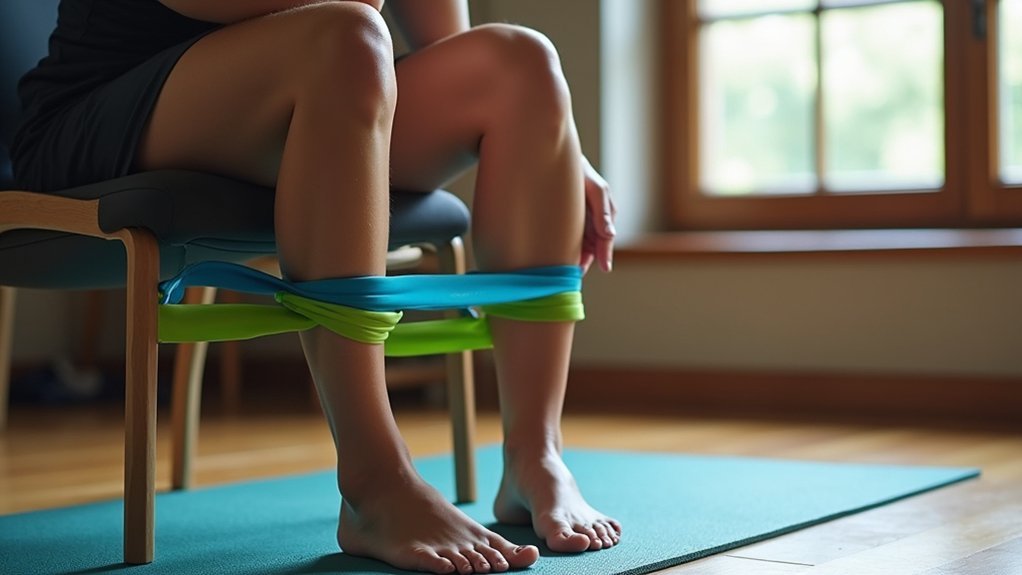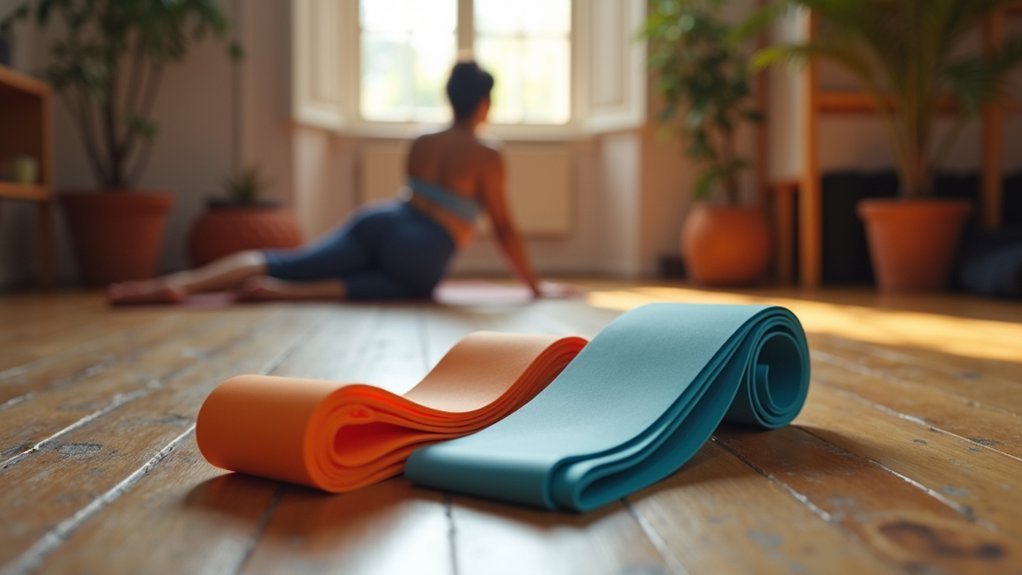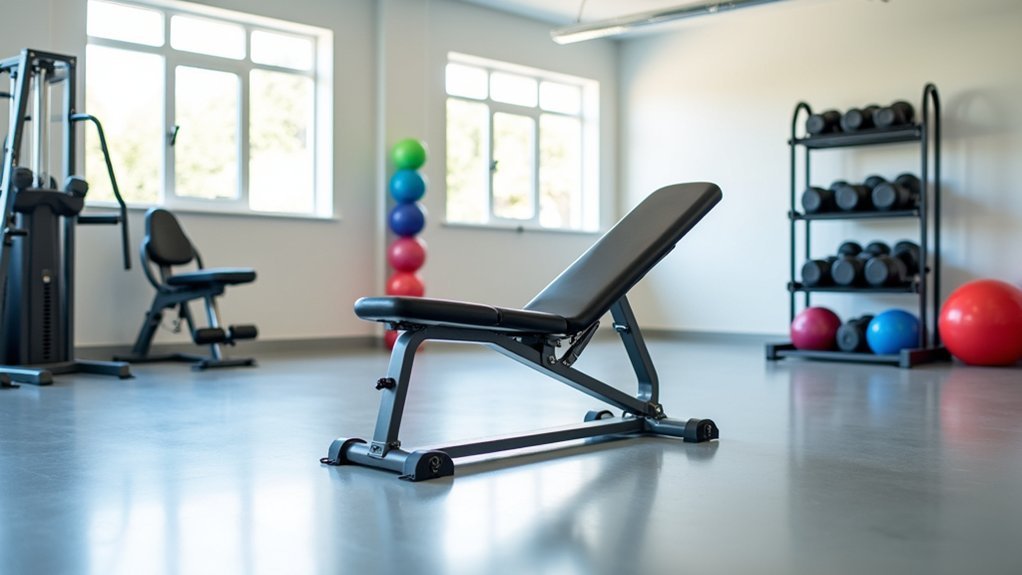Exercise bands offer an ideal fitness solution when you’re dealing with mobility limitations. You can build strength and improve flexibility from a seated position using these versatile tools. Choose bands with appropriate resistance levels that challenge your muscles without causing strain. For best results, start with 15-30 minute sessions 2-3 times weekly, focusing on proper form and controlled movements. The following techniques will transform how you approach fitness despite mobility challenges.
Understanding Exercise Bands for Limited Mobility

Versatility makes exercise bands one of the most accessible fitness tools for those with mobility challenges.
These stretchable rubber or latex bands provide adjustable resistance that’s ideal for strength training exercises when movement is restricted.
Resistance bands offer gentle yet effective training options precisely when your body needs modified movement patterns.
Available as loop bands or tubes with handles, resistance bands enable you to improve mobility through a full range of motion while seated or standing. They enhance muscle engagement and joint stability without placing undue stress on your body, reducing injury risk compared to traditional weights.
Because they’re portable and lightweight, you can enhance physical activity anywhere—at home, in a care facility, or while traveling.
This adaptability helps you maintain consistency, which is essential for developing strength and flexibility that transfers to daily activities.
Selecting the Right Exercise Bands for Your Needs
When choosing exercise bands for limited mobility, you’ll want to select appropriate resistance levels that challenge your muscles without causing strain or discomfort.
Your bands should stretch with moderate effort, allowing you to complete full movements while still feeling tension throughout the exercise.
Quality band materials like latex or TPE offer ideal elasticity and durability, though you may prefer latex-free options if you have allergies or sensitivities.
Resistance Levels Matter
Selecting the right resistance level stands as one of the most essential decisions when using exercise bands for limited mobility.
You’ll need to find bands that challenge your muscles without sacrificing proper form. Start with lighter resistance to master exercise techniques before advancing to stronger bands as your strength improves.
- Color-coding indicates different resistance levels, making selection straightforward
- Proper tension allows full movement while still engaging targeted muscle groups
- Using too heavy resistance increases injury risk for those with mobility limitations
- Progress gradually as your strength and confidence improve
- Invest in a set with varying resistance for adaptability as your needs change
Band Material Considerations
The materials used in exercise bands greatly impact their performance and suitability for those with mobility challenges. When selecting resistance bands, pay attention to both the material composition and physical dimensions. Most quality elastic bands are made from latex or rubber, providing the ideal stretch and durability needed for rehabilitation exercises.
Consider the thickness and width of bands carefully—thicker bands offer increased resistance, while wider ones provide better support for larger movements. If you’re using bands for rehabilitation, look specifically for those labeled as “therapeutic” or “physical therapy” bands, as they’re designed to be gentler on sensitive joints.
Your comfort matters too. Some resistance bands feature handles or padded grips, which can greatly improve usability when your mobility is limited.
Always choose an appropriate resistance level to guarantee effective, safe workouts.
Seated Upper Body Strengthening Exercises

Boost your upper body strength from a seated position with targeted band exercises that include bicep curls, shoulder presses, and chest presses.
You’ll find that working your chest and back muscles with resistance bands provides balanced development while preventing muscle imbalances that can affect posture.
Incorporating shoulder mobility techniques such as external rotations and lateral raises will help maintain range of motion and prevent stiffness in these essential joints.
Bicep Curls and Presses
Seated bicep curls and presses offer two powerful exercises that can transform your upper body strength without requiring you to stand or move around.
These resistance band exercises are perfect if you have limited mobility but still want to improve your arm strength and endurance. For bicep curls, keep your elbows close to your sides while performing 8-12 repetitions with proper form.
Combine these with band presses to engage your chest and shoulders for thorough upper body conditioning.
- Adjust resistance by shortening the band or using a heavier one as you progress
- Perform 8-12 repetitions of each exercise for ideal strength building
- Keep elbows tucked against your sides during bicep curls for proper technique
- Combine curls with presses to target multiple muscle groups simultaneously
- Regular practice enhances functional strength for everyday activities
Chest and Back Work
Two essential exercises form the cornerstone of seated chest and back training with resistance bands: chest presses and lat pull-downs. These movements effectively target your major upper body muscles while accommodating limited mobility.
For chest presses, position the band behind your back and press forward, engaging your chest while mobilizing your shoulders. With lat pull-downs, you’ll strengthen your upper back by moving your hands apart against the resistance, improving posture and stability.
| Exercise | Muscles Worked | Reps | Benefits | Form Tips |
|---|---|---|---|---|
| Chest Press | Pectoral, Deltoids | 8-12 | Shoulder mobility | Keep elbows at 90° |
| Lat Pull-Downs | Latissimus Dorsi | 8-12 | Enhanced posture | Pull with shoulders |
The variable resistance of bands allows you to adjust difficulty based on your strength level, building muscle endurance while promoting progress in your seated workout routine.
Shoulder Mobility Techniques
Improving shoulder mobility remains an essential goal for those with limited movement options, especially when traditional exercises pose challenges.
Using resistance bands while seated offers an effective way to strengthen your upper body and improve flexibility without standing. These exercises target rotator-cuff muscles and enhance shoulder stability, making daily tasks easier.
- The Dumb Waiter exercise specifically targets shoulder muscles to increase functional movement.
- Lateral Raises with bands provide adjustable tension as your strength improves.
- Regular practice builds muscle endurance and reduces stiffness in your upper body.
- Band exercises can be modified for various fitness levels by changing band resistance.
- Consistent training improves your ability to reach and lift objects with greater confidence.
With these seated techniques, you’ll develop stronger shoulders while working within your mobility limitations.
Chair-Based Lower Body Resistance Training

For individuals with limited mobility, chair-based lower body resistance training offers a safe and effective way to build strength without standing.
By incorporating resistance bands into your seated routine, you’ll engage major muscle groups including quadriceps, hamstrings, and glutes while minimizing fall risks.
Resistance bands transform chair exercises into powerful strength builders, targeting crucial leg muscles without compromising safety.
These versatile bands allow you to adjust resistance levels to match your current abilities, making gradual progression possible as your strength improves.
Exercises like seated leg extensions and leg presses not only build muscle but also enhance joint stability—crucial for daily activities.
What makes this approach particularly valuable is how it improves overall mobility and physical function.
With consistent training, you’ll likely notice improvements in everyday movements, contributing to greater independence and quality of life despite mobility limitations.
Building Daily Routines With Exercise Bands
While consistency remains the key to fitness success, establishing a daily exercise band routine can transform sporadic workouts into sustainable habits for those with mobility challenges. By dedicating just 15-30 minutes daily to resistance bands, you’ll gradually build strength and improve mobility regardless of your fitness level.
- Create a structured weekly plan alternating between upper body exercises one day and lower body work the next.
- Start with seated positions if standing is difficult, then progress as your stability improves.
- Maintain constant tension in your bands to maximize muscle engagement during mobility training.
- Increase resistance gradually as you grow stronger, ensuring your full-body workout remains challenging.
- Schedule short sessions at the same time each day to develop an exercise routine that sticks.
Progressing Safely With Resistance Training
Once you’ve established your daily exercise band routine, the next step involves moving forward safely with resistance training.
Select bands that provide enough tension for muscle engagement without compromising your form, ensuring a safe introduction to strength work.
As you build strength, create progressive overload by shortening bands or switching to higher resistance options.
Focus on controlled movements and proper form during each exercise to maximize results and prevent injury.
Diversify your exercise targets by incorporating moves for different muscle groups, promoting balanced strength development.
Schedule 2-3 sessions weekly, allowing for adequate muscle recovery between workouts.
Your mobility work will benefit most when you pay careful attention to body mechanics, maintaining proper alignment throughout each movement while gradually challenging yourself with increased resistance.
Frequently Asked Questions
What Is the Best Exercise for People With Limited Mobility?
For limited mobility, swimming offers low-impact, full-body exercise that reduces joint strain. You’ll improve strength, flexibility, and cardiovascular health while water’s buoyancy supports your body, making movement easier and safer.
Do Resistance Bands Help With Mobility?
Yes, resistance bands help improve your mobility. They provide gentle resistance that enhances flexibility, strengthens specific muscle groups, and increases your range of motion. You’ll notice reduced stiffness and improved stability with regular use.
What Is the Best Exercise if You Can’t Walk?
You’ll find chair exercises with resistance bands most effective if you can’t walk. Try seated leg extensions and rows to strengthen major muscle groups while improving flexibility and functional strength without standing.
What Are the Disadvantages of Resistance Bands?
Resistance bands can break if overstretched, offer limited resistance for advanced training, make proper form difficult, slip during workouts, and restrict range of motion compared to traditional weights. You’ll need alternatives for maximum strength gains.
In Summary
Exercise bands are your valuable allies when mobility challenges arise. You’ve now got the knowledge to select appropriate bands, perform seated exercises, and create sustainable routines. Remember, it’s not about pushing to exhaustion—it’s about consistency and gradual progression. As you continue incorporating these flexible tools into your daily life, you’ll likely notice improved strength, enhanced range of motion, and greater confidence in your physical abilities.





Leave a Reply